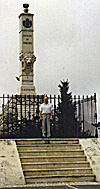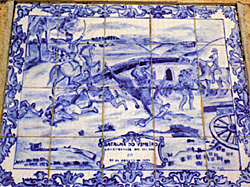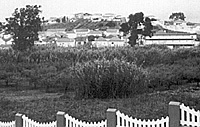 The Monument to the battle on Vimeiro Hill marking the area where Fane's and
Anstruther's brigades fought. (That's me [author John Grehan] by the way!)
The Monument to the battle on Vimeiro Hill marking the area where Fane's and
Anstruther's brigades fought. (That's me [author John Grehan] by the way!)
Junot was beaten as much by the terrain as by the British infantry. The southern faces of both of the heights which formed the main allied position were in themselves considerable obstacles and when defended by a superior enemy they were almost insurmountable. Vimeiro Hill, though far less formidable, protected the centre of the allied line and any attack against either the Valongo or the Mariano ridges would have the hill on its flank.
Vimeiro Hill, therefore, had to be taken before any progress could have been made against Wellesley's position. With Fane's riflemen occupying the wood in front of the hill it meant that Wellesley had three layers of defence through which Junot's infantry had to fight.
Nevertheless, Junot might well have won at Vimeiro if he had used the features of the ground to his advantage. His chief of staff, General Thiebault, left us his opinions of the battle in his Memoirs. He states that Wellesley's left flank "rested on nothing" and that "nothing could have been clearer than our correct course at Vimeiro." He saw that a frontal attack was out of the question, "but we should have done everything to cause the belief that such an attack had been determined on, by throwing up batteries, covering the ground with skirmishers, making a number of feigned reconnaissances leading to as many skirmishes, showing the heads of our columns.
 A Portuguese tile painting on the Vimeiro monument. The eastern and western heights can
clearly be seen separated by the Maceira valley.
A Portuguese tile painting on the Vimeiro monument. The eastern and western heights can
clearly be seen separated by the Maceira valley.
These demonstrations should have occupied the 21st; and at night, leaving the reserve under Kellermann to look like an advance guard, we should have pushed Delaborde's and Loison's divisions, plus 600 cavalry and 15 guns between Lourinha and the enemy's left.
Before day we should have been in force on the plateau on which the English camp leaned, and "their general, having lost all his advantages of position, would have found himself at grips with an army which was turning his flank."
 Two linked photographs showing almost the whole of the Vimeiro position
seen from Vimeiro Hill. On the left is the Valongo ridge and in the centre is the
Maceira valley. To the right is the start of the eastern heights, (or Mariano ridge), stretching almost to Ventosa on the right.
Two linked photographs showing almost the whole of the Vimeiro position
seen from Vimeiro Hill. On the left is the Valongo ridge and in the centre is the
Maceira valley. To the right is the start of the eastern heights, (or Mariano ridge), stretching almost to Ventosa on the right.
As can be seen from the photograph of the Mariano ridge, its top is broad and relatively flat and the French cavalry and artillery could have manoeuvred along it without difficulty whilst their allied counterparts could not have climbed the hill to assist their exposed infantry. If Junot would have attacked the Mariano ridge in strength Britain's involvement in the Peninsular War might have ended on that open plateau almost before it had begun.
 Vimeiro Hill. Covered in vines and thickets at the time of the battle, now covered with
buildings.
Vimeiro Hill. Covered in vines and thickets at the time of the battle, now covered with
buildings.
Bibliography
Fortescue J. A History of the British Army, Vol. VI. 1921
Foy M. History of the War in the Peninsula, Vol. II. 1827.
Glover M. Britannia Sickens. 1970
Napier W. History of the War in the Peninsula Vol I 1835 (1992 re-print by Constable & Co.)
Oman C., A History of the Peninsular War 1902 (1995 re-print by Greenhill Books)
Thiebault P. The Memoirs of Baron Thiebault, Vol. II. 1896
More Vimeiro
-
Vimeiro: Introduction
Vimeiro: The Defenders (and British OOB)
Vimeiro: The Attackers (and French OOB)
Vimeiro: The Battle
Vimeiro: Observations
Related
Back to Battlefields Vol. 1 Issue 8 Table of Contents
Back to Battlefields List of Issues
Back to Master Magazine List
© Copyright 1999 by Partizan Press.
This article appears in MagWeb (Magazine Web) on the Internet World Wide Web.
Other military history articles and gaming articles are available at http://www.magweb.com